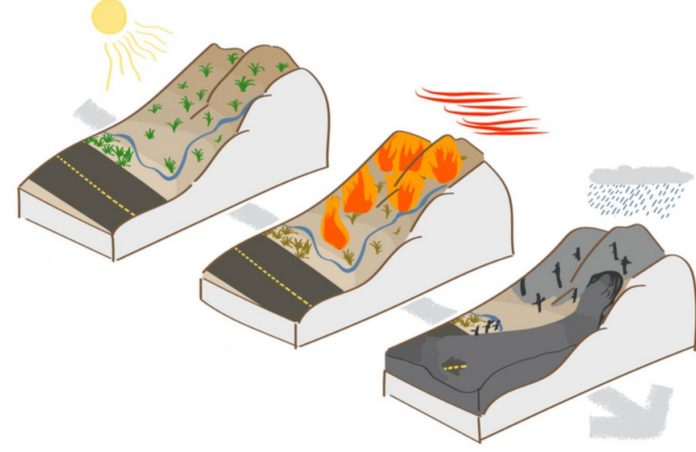Wildfires followed by heavy rainstorms are often a bad combination. Without vegetation to absorb the impact of rainfall, water runoff can transform into a sudden, extremely destructive landslide known as a “debris flow,” which frequently has the potential to destroy cars, homes, and highways and sometimes even kill people.
Researchers from Northwestern University have enhanced a physics-based numerical model to explore and predict debris flow-prone regions. This improved model could be used in the future to help people in high-risk areas get early warnings so they can leave before it’s too late. Designing new infrastructure for high-hazard zones, such as diversion bars that divert swiftly flowing water away from homes and roadways, might also be done using information from model simulations.
The findings were published in the journal Natural Hazards and Earth System Sciences today.
The study’s lead author, Daniel Horton from Northwestern, said, “People want to know about their immediate and future risk.”
This modeling framework “could one day be instrumental in forecasting where debris flows are likely to occur and deciding who needs to be evacuated.”
Horton oversees the Climate Change Research Group while serving as an assistant professor of Earth and planetary sciences in Northwestern’s Weinberg College of Arts and Sciences.
The paper’s first author is Horton’s lab doctoral student Chuxuan Li.
Increasing debris ‘ingredients’
Debris flows may become more frequent when the risk of wildfires and heavy rainfall increases as a result of global warming. A 150-foot portion of Highway 1 at Big Sur, California, was ripped apart by a debris flow last year. The beautiful two-lane highway was closed for three months, making it impossible for people to visit the area.
A combination of two factors led to the disastrous outcome: A wildfire that raged from August to December 2020, followed by an atmospheric river — a long, thin ribbon of concentrated moisture in the sky — that dumped about a foot of rain in January the next year.
Areas that have been previously devastated by wildfires are more likely to experience flash flooding in the aftermath of heavy rains. Typically, rain interacts with vegetation before percolating into the ground. However, after a fire, the vegetation is no longer present and cannot stop the sudden influx of moisture. Worse yet, in some places, wax from burning plants melts, seeps into the earth, and then solidifies. These waxes prevent rain from reaching the soil by acting as a barrier. Instead, rain puddles on top of the ground and picks up detritus like pebbles, mud, trees, and even cars.
The factors that create debris flows are unquestionably growing more prevalent, according to Horton, who attributed human-caused climate change to this. “Due to intensified precipitation, drought and wildfires, debris flow conditions are particularly prevalent in California.”
Identifying vulnerable locations
Horton’s team used the National Water Model from the National Oceanic and Atmospheric Administration, which is used to simulate streamflow and water resources across the continental United States, to make the new model.
“The National Water Model is a community, open-source model, so researchers use it to probe all sorts of pertinent water resource and hazard questions,” adds Horton. “But one thing the model didn’t explicitly output was overland flow — water that runs across the land after rainfall. We modified the model to look at how extreme precipitation moves over land surfaces, which allows us to investigate how susceptible certain land surfaces, and in particular burn scars, are to debris flow.”
The researchers were able to simulate how water flows over wildfire burn scars by varying soil characteristics and vegetation type (for example, dense vs. bare vegetation). Using observations of streamflow and soil moisture, the team subsequently verified the hydrological conditions that the model had predicted.
The simulation that resulted showed that compared to unburned land, burned areas cause water to flow far more quickly and in larger amounts. The researchers discovered that overland flow volume rose eight-fold and peak flow tripled in comparison to the ground without burn scar features while replicating the debris flow that devoured Highway 1, for instance.
“An advantage of our model is that it uses precipitation as it would fall in the real world,” Horton adds. “We’re simulating spatially complex and time-evolving precipitation and how that precipitation interacts with the land surface.”
“Our physics-based hydrological model opens up new possibilities for better understanding of burn scar hydrology and debris flow susceptibility,” Li adds. “Given the increasing likelihood of debris flow conditions due to climate change, developing models to better understand past events and predict future events is essential.”
Image Credit: Getty
You were reading: New Model Can Calculate Current And Future Landslide, Wildfire Risk – Scientists
